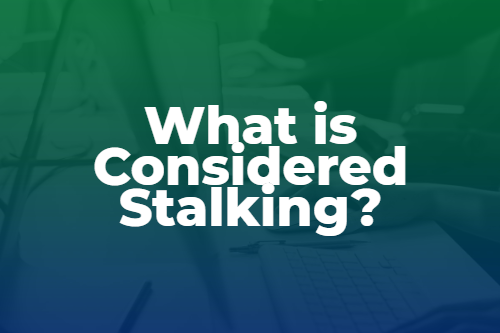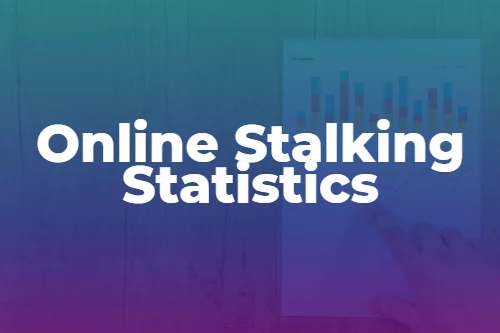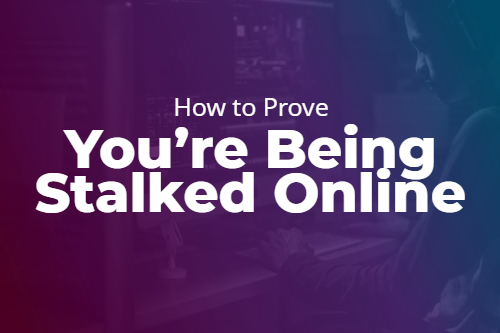
How to Prove You’re Being Stalked Online
This page has been peer-reviewed, fact-checked, and edited by qualified attorneys to ensure substantive accuracy and coverage.
In this comprehensive blog post and article, we’re going to walk you through how to prove you’re being stalked online, what’s considered stalking, how to identify online stalkers, and more!
- To prove you’re being stalked online, we recommend following these four steps:
- Make sure to document everything,
- Construct a thorough timeline of the cyberstalking and online harassment,
- Set all your online profiles to private,
- Familiarize yourself with your state’s respective cyberstalking and online harassment laws.
Finally, if you’re being stalked online, it’s imperative you reach out to an experienced Internet attorney as soon as possible.
- Cyberstalking, sometimes referred to as online harassment, is the repeated act of stalking, harassing, or intimidating a person or entity by electronic means. It may also be commonly referred to as “cyberbullying,” however, do note that cyberbullying is typically used to describe cyberstalking and online harassment of a person under the age of 18.
Online Stalking Protection Tip: Responding or retaliating against online stalkers can be a slippery slope. While it might seem appropriate to respond, doing so could actually anger an online stalker, which could ultimately lead to real-life violence. Additionally, most online stalkers are seeking out a reaction, so refraining from giving in to their plan can help shift the power back in your favor. Your attention should be focused on the most important task at hand – preserving and documenting all evidence.
Have you been the victim of stalking or online stalking and want it to stop? Contact the experienced Internet defamation attorneys of Minc Law today! At Minc Law, we provide a comprehensive range of legal services to help both individuals and businesses combat online defamation, sextortion, online harassment, blackmail, and cyberstalking (online stalking).
We know what it takes to uncover anonymous online identities and personas in order to hold individuals liable for online harassment and stalking. Utilizing an experienced Internet attorney to locate online stalkers and harassers is essential for giving yourself the best chance to succeed in stopping repeated online attacks.
With a team of experienced attorneys, we will fight for the closure you deserve. Take back control today.Don't suffer in silence.
So, what are you waiting for? Let’s put an end to the online abuse and attacks NOW!
To schedule your free, initial no-obligation consultation with an intake specialist, reach out to us at (216) 373-7706, or schedule a meeting with us by filling out our online contact form.

What is Considered Stalking? Traditional Stalking vs. Online Stalking
Stalking is simply the unwanted and repeated following or surveillance of a person by another and is commonly intertwined with other worrisome behaviors, such as harassment, intimidation, threats, and physical violence. Specifically, the U.S. Center for Victims of Crime defines stalking as “virtually any unwanted contact between two people that directly or indirectly communicates a threat or places the victim in fear…”
According to a 2011 survey conducted by the the CDC on the prevalence and characteristics of sexual violence, stalking, and intimate partner violence victimization, over 7.5 million individuals were stalked in a single year (2011), with roughly 61% of female victims and 44% of male victims being stalked by a current or former intimate partner.
Unfortunately, with the rise of user-generated content bulletin boards, social media websites, and other popular online platforms, stalkers now have a (relatively) new and extremely powerful means to harass, monitor, and intimidate their victims.
Now, instead of having to physically locate a person by searching through a phone book, online stalkers are able to conduct Internet and social media searches at the drop of a hat. Stalkers are now able to terrorize innocent persons from the comfort of their own home. Real-life stalking and online stalking are also heavily intertwined, making for a 24/7 barrage of terror and threats for some victims.
So, what’s the difference between traditional stalking and online stalking?
Real-Life Stalking vs. Online Stalking
Also known as cyberstalking, online stalking refers to the repeated act of stalking, intimidating, or harassing a person or organization by electronic means. Cyberstalking may also be referred to as “cyberbullying.” However, do note that cyberbullying is generally used to refer to the stalking and harassment of minors. Online stalking, like traditional stalking, typically seeks to accomplish the following four things:
- Identification and locating of the victim,
- Repeated surveillance,
- An accompanying act (ex. Harassment, threats, abuse), and
- Manipulation.
Generally, cyberstalking will also include one of the following components:
- Defamation (most commonly libel),
- False accusations and allegations,
- Copyright infringement,
- Revenge porn.
But, that’s not all. Online stalking may also include highly illegal and threatening accompanying acts, such as: indirect and direct threats of violence, identity theft, vandalism, and solicitation of sexual imagery and acts.
Do note that it’s extremely common for people to confuse cyberstalking (online stalking) with cyber-trolling. Cyber-trolling is typically considered harmless and occurring only one or two times. Cyberstalking, on the other hand, refers to a repeated campaign of online stalking, harassment, and intimidation. Additionally, cyberstalkers and online harassers generally have some form of a game-plan, while cyber-trolls engage in “trolling” sporadically and without previous thought.
Online Harassment Tip: Looking for a comprehensive list of tips to avoid online harassment and cyberstalking? Check out our recent article, “5 Steps to Protect Against Cyberstalking & Online Harassment“.

Online Stalking Statistics in the United States
As noted above, cyberstalking in the United States has increased significantly over the years due to the countless social media and user-generated content platforms and applications popping up by the day.
Let’s take a look at several alarming cyberstalking and online harassment statistics in the United States just to gauge how common this cyber-phenomenon has become.
A 2009 National Crime Victimization Survey by the U.S. Department of Justice estimated roughly 14 out of every 1,000 persons aged 18 or older will experience stalking at some point in their lives – with over 3.4 million persons (aged 18 or older) falling victim per year.
And, while the above statistics refer to traditional stalking methods (real-life stalking), an estimated 25% of all stalking victims reported some form of cyberstalking, such as email or instant messaging, as the primary means of communication and intimidation.
So, what are the most common causes of cyberstalking and online harassment in the U.S.?
Most Common Forms of Stalking in the U.S.
Two cyberstalking lecturers and researchers, Paul Bocij and Leroy McFarlane noted four distinct types of cyberstalking in a 2003 exploration of predatory behavior in cyberspace:
- Intimate cyberstalkers and online harassers who seek out a relationship with a victim
- A cold and calculated cyberstalker merely seeking to annoy an individual,
- A cyberstalking seeking revenge, and
- A collective group of cyberstalkers and online harassers seeking to further a group motive.
Real-life stalking and cyberstalking don’t generally occur across as a short time-span either, with a SPARC study noting the average duration of stalking to typically exceed two years (and longer for intimate partners).
Let’s turn to a few other relevant statistics which accompany cyberstalking and online harassment in the U.S.
- Electronic monitoring devices were used to stalk roughly 1 in 13 victims
- Listening devices and bugs were the primary means to electronically monitor victims
Cyberstalking and online harassment is a very present reality for anyone, so it’s important to remain vigilant regardless of your age, race, creed, or location. Proactivity trumps reactivity when it comes to cyberstalking, sextortion, and online harassment, as seemingly innocuous online actions and conduct can ultimately manifest themselves in real-life physical violence in no time.
Defamation Law Fact: Due to the United State’s long-standing enforcement of the First Amendment and free speech, it is generally considered a pro-defendant defamation jurisdiction. European countries and other Commonwealth legal jurisdictions (United Kingdom, Canada, Australia) on the other hand, are typically considered pro-plaintiff defamation jurisdictions.

How to Prove You’re Being Stalked Online
Proving you’re being stalked online can sometimes be difficult, as the perpetrator may be obfuscating their identity via privacy software and routing networks or located overseas. In this section, we’re going to walk you through several ways to prove you’re being stalked online and how to ultimately help give yourself the best fighting chance when bringing a legal claim, seeking a court order, or removing false and malicious content.
A general rule of thumb when confronting online harassment and cyberstalking is to assess your immediate circle of friends, family, and acquaintances.
Cyberstalking Protection Tip: Several common defenses to cyberstalking and Internet harassment lawsuits include: (1) No imminent threat of danger, (2) Lack of requisite intent, (3) False accusations, and (4) Not unwanted or made repeatedly. If you wish to determine whether one of these defenses is applicable in your case, we recommend contacting an experienced internet harassment lawyer.
1. Document Absolutely Everything!
Without any shred of evidence, proving you’re being stalked in real life and online can be extremely difficult – therefore, we strongly recommend documenting and preserving all communications, posts, photographs, and other media posted and sent by the cyberstalker or perpetrator.
While it might seem natural to want to delete threatening messages and media sent to you by a malicious cyberstalker, don’t! Doing so could ultimately lead to an uphill battle when presenting your case before a court or contacting an Internet Service Provider. Furthermore, documenting all relevant and offensive communications and posts may help refute claims by the opposing party that you’ve tampered with evidence.
We also recommend having a trusted friend or family member to assist with the process, as to not miss anything.
As we’ll touch on below, cyberstalking and cyberbullying laws in the U.S. leave much to be desired, so it’s incredibly important to paint as clear a picture as possible.
2. Construct a Timeline of the Harassment
Constructing a cohesive timeline of the cyberstalking and online harassment experienced is an essential step towards painting a clear picture for a judge/court. Opposing parties may sometimes choose to discredit an individual’s claim based on a lacking or incomplete timeline, so it’s extremely important to note both the date and time of all cyberstalking communications, threats, and harassment.
Create a time-log, in which you may easily chronicle the threatening and intimidating behavior of a cyberstalker or online harasser.
This also includes chronicling and detailing the dates and times you contact police. It’s important to show that you’ve sought help and assistance with the matter, as the opposing side (the perpetrator) might ultimately argue that there was no imminent threat, repeated stalking or actions, or other actual intimidating behavior because you did not, in fact, seek out a police officer.
Unfortunately, not everyone keeps easily accessible or reliable records (and sometimes none at all), so it’s up to you to document the process as meticulously as possible.
3. Set All Online Profiles to Private
Limiting the amount of personal information that makes its way to the general public is an effective way to prove you’re being stalked. We recommend making all major social media profiles and accounts private. If personal information and photographs aren’t easily accessible to the general public, a cyberstalker is going to have a much tougher time explaining how they procured access to it.
Minimizing one’s digital footprint is crucial for combating cyberstalking and online harassment.
We also recommend setting up Google Alerts, or another Internet search monitoring service to receive notifications anytime your name or inserted keywords are mentioned anywhere online. Doing so will enable you to document all the places where personal information, threats, and other attacks are posted.
4. Familiarize Yourself With Your State’s Cyberstalking Laws
While the cyberstalking and internet harassment landscape can be quite difficult to navigate, we recommend checking out your state’s cyberstalking, online harassment, and sextortion laws.
Cyberstalking is a crime in the United States. However, the legal code leaves much to be desired and fails to properly differentiate between several differing crimes; cyberstalking, online harassment, and cyberbullying. The core federal anti-cyberstalking law which is most often applied and cited is 47 U.S. Code § 223, which reads:
“(1) Whoever, in interstate or foreign communications, by means of a telecommunications device knowingly, makes, creates, or solicits, and initiates the transmission of, any comment, request, suggestion, proposal, image, or other communication which is obscene or child pornography, with intent to abuse, threaten, or harass another person…”
Present-day cyberstalking actions are usually criminalized under U.S. anti-harassment, anti-stalking, and surprisingly, slander statutes and laws.
Unfortunately, there is a lack of comprehensive cyberstalking legislation at the federal level, which leaves enforcement in the hands of your state. To read up further on cyberstalking and online harassment laws at both the state and federal level, we recommend checking out our past blog post and article, “5 Steps to Protect Against Cyberstalking & Online Harassment“, for help tackling several laws you should familiarize yourself with.
Sextortion Protection Tip: Sextortion is defined as a specific type of sexual exploitation whereby a person utilizes non-physical means of coercion to extort sexual acts and imagery from an innocent person. At the very heart of a sextortion claim is an abuse of power by one party, and an accompanying threat. Sextortion, like cyberstalking has seen a drastic increase in cases over the past decade, with over 13,000 sextortion reports made to the FBI in July of 2018 alone.

Work With an Experienced Internet Attorney Today to Stop Cyberstalking!
Have you been the victim of cyberstalking or cyberbullying and want to put an end to it today? Reach out to the experienced Internet defamation attorneys of Minc Law now! At Minc Law, know the ins and outs of U.S. defamation and Internet law, and have proven success stopping malicious cyberstalkers and online harassers.
Furthermore, in our tenure as nationally recognized Internet attorneys, we’ve built up a comprehensive arsenal of legal tactics to identify anonymous online cyberstalkers and harassers. We’ve also secured the effective and seamless removal of over 25,000 pieces of false and libelous content/web pages, litigated in over 22 states and 3 countries, and boast a near 100% online defamation removal rate.
What are you waiting for? Let’s put an end to the online harassment and attacks today.
What can you expect when working with the Cleveland-based Internet lawyers of Minc Law?
- Utmost Courtesy & Respect: At Minc Law, we know just how stressful and overwhelming cyberstalking and online attacks can be, so know that we’re here to make the process as smooth as possible. After all, your goals are our goals.
- Open Communication & Dialogue: It’s not uncommon for some Internet attorneys to go missing once they’ve begun the defamation removal or cyberstalker identification process. Not us. We understand how important it is to stay informed about all details surrounding your case. When working with the Ohio-based Internet lawyers of Minc Law, we’ll always make sure to keep you in the loop.
- We Get Results: We have proven success identifying anonymous cyberstalkers and online harassers, and know what it takes to hold them liable for their actions. In our Internet defamation and investigations practice, we’ve worked tirelessly with numerous online content managers, website administrators, and third-party arbitration firms to identify malicious posters/commenters and remove malicious materials and content. Websites and businesses respond to Minc Law!
To schedule your free, initial no-obligation consultation with an intake specialist, call us at (216) 373-7706, or schedule a meeting by filling out our online contact form.
The online abuse stops now!
★★★★★
“Minc law set the bar for professionalism throughout my experience with them. They responded within minutes for the majority of my requests or concerns. I highly recommend them for their services and appreciate how they made the experience very personal and attentive.”
P.N., December 22, 2021


